What Is SORA And How Does It Work?
- by Stefan Gandhi
The UK’s professional drone sector is rapidly evolving and regulatory compliance is at the heart of safe and successful operations. One framework gaining increasing attention is SORA, the Specific Operations Risk Assessment. For commercial drone pilots, SORA is more than a bureaucratic step. It is a structured method to assess and mitigate risk, opening the door to operations that fall outside standard or predefined scenarios. Understanding how it works can give operators the knowledge to plan complex missions with confidence, secure approvals more efficiently and improve safety standards across their workflow.
Understanding the purpose of SORA
SORA was designed to provide a consistent, evidence-based way to evaluate the risks associated with specific drone operations. It is primarily used in situations where an operator’s planned activity does not fit within the Civil Aviation Authority’s (CAA) standard scenarios or pre-defined risk assessments. By following the SORA process, operators can identify potential hazards, assign a measurable level of risk and apply mitigation strategies that satisfy regulatory requirements.
For UK professionals, SORA has particular value in enabling bespoke missions such as beyond visual line of sight (BVLOS) flights, operations near sensitive areas or high-population zones, and flights using specialised sensors or payloads.
The core principles of SORA
SORA is built on a structured risk methodology. It evaluates two main categories of risk:
- Ground Risk Class (GRC), which measures the potential harm to people and property on the ground in the event of an incident.
- Air Risk Class (ARC), which considers the probability of a collision with other airspace users.
These risk classes are combined to determine the Specific Assurance and Integrity Level (SAIL). This final index reflects the level of regulatory oversight, operational safety objectives and technical mitigations needed for the proposed mission.
The step-by-step process of SORA
SORA follows a defined sequence of stages to take operators from concept to approval.
1. Define the Concept of Operations (ConOps)
The process begins with a detailed description of the intended mission. This includes operational area, altitudes, duration, type of drone and crew details.
2. Determine the Ground Risk Class
This step uses operational parameters to calculate GRC. Factors such as overflight of people, built-up areas and potential emergency landing zones are considered.
3. Apply strategic ground risk mitigations
Measures like using smaller drones, avoiding populated zones or restricting flight times can reduce GRC.
4. Determine the Air Risk Class
ARC is calculated based on airspace type, density of manned aviation traffic and proximity to controlled areas.
5. Apply strategic air risk mitigations
These might include airspace segregation, operational altitude limits or traffic awareness systems.
6. Determine the Specific Assurance and Integrity Level
SAIL is derived from the combined GRC and ARC results. The higher the SAIL, the more stringent the safety requirements.
7. Identify operational safety objectives
Each SAIL level comes with associated safety objectives, covering everything from maintenance protocols to crew competence.
8. Apply tactical mitigations
Additional measures such as detect-and-avoid technologies, onboard safety systems, or advanced training can help meet the required safety objectives.
9. Verify compliance with safety objectives
Operators must demonstrate that all required safety measures are in place, documented and testable.
10. Submit to the CAA
The completed SORA package is submitted to the regulator for review and, if approved, forms the basis of the operational authorisation.
Benefits of SORA for professional drone operators
For professionals working in surveying, inspection, security, filmmaking or public safety, SORA brings tangible advantages:
- Flexibility to conduct complex or unique missions that standard scenarios cannot cover.
- Clear risk management that builds client trust and strengthens operational planning.
- Regulatory credibility when approaching large contracts or tenders.
- Long-term efficiency by establishing repeatable processes for future mission planning.
Challenges in using SORA
While SORA is powerful, it can be complex for first-time users. The technical nature of the risk calculations, combined with the requirement for detailed documentation, means that preparation is key. Many UK operators choose to undertake training courses that break down the methodology and provide real-world application examples. Without a clear understanding, there is a risk of over- or under-estimating operational hazards, which can delay CAA approvals.
FAQs
What does SORA stand for?
SORA stands for Specific Operations Risk Assessment, a structured process for evaluating and mitigating risks in drone operations that fall outside standard categories.
When do I need to use SORA in the UK?
You will need SORA when your planned drone operation does not fit within the CAA’s predefined risk assessments or standard scenarios. This is common for BVLOS flights or operations in higher-risk environments.
How long does SORA approval take?
The timeframe varies depending on the complexity of the operation and the completeness of your submission. Some approvals can take several months.
What is the difference between SORA and PDRA?
A PDRA, or Pre-Defined Risk Assessment, is a ready-made risk model that can be applied to certain common operations. SORA is used for bespoke, higher-complexity operations where no PDRA is available.
Do I need special equipment to meet SORA requirements?
Depending on the risk level, you may need additional safety systems such as detect-and-avoid technology, parachute recovery systems or enhanced navigation tools.
Conclusion
SORA is an essential framework for UK drone professionals looking to expand their operational capabilities beyond standard limits. By systematically identifying and mitigating risk, it not only satisfies CAA requirements but also improves safety, client confidence and operational flexibility. For those seeking to take on more complex projects and operate in challenging environments, understanding and applying SORA is a valuable step.
Enrol today in our Introduction To SORA online course here via the Coptrz official online store and gain the skills to approach complex missions with confidence.




